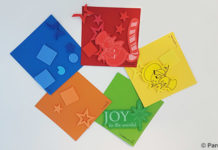Age
Two to four years
Duration of activity
This activity requires intense concentration, but children should be able to persist with it for about 15 minutes. If your child starts trying to eat the macaroni or feed it to the dog, it’s probably time to put the activity aside for another day.
Materials/equipment
- Small cardboard box- the box of a small household appliance would be a good size.
- Macaroni
Cost
This activity will not cost anything to make.
Preparation
- Poke different sized holes in the cardboard box using a knife of other sharp implement. For the smaller holes you can use a pen to poke the holes if the cardboard is not too thick. Some of the holes should be large enough that a piece of macaroni can easily be pushed through. Others should be small enough so that the macaroni needs a bit of a push to fit through.
What to do
- Show your child the box and show them where the holes are.
- Show them the macaroni and count the pieces.
- Instruct them to take a piece of macaroni and push it through one of the holes. If you are just starting to play this game, use one of the bigger holes to push the first piece of macaroni through so that it is easier for your child.
- Ask your child to continue pushing the macaroni into the box, using different holes, until all the pieces are inside.
Tips
- Talk about the macaroni and the holes in the box as you play this game, for example ask your child about the shape, size and colour or the macaroni and the holes.
- Encourage your child to talk about how they experience this game, for example which holes are easy and difficult to push the macaroni through, how they feel when they succeed, and how they feel when the macaroni is hard to push through.
Extension activities
- For older children label the holes on the box and the pieces of macaroni with corresponding numbers (or the letters of the alphabet). Instruct your child to stick each piece of macaroni through the hole with the matching number.
- Use different types of pasta which are bigger (e.g. spirals) and smaller (e.g. spaghetti) than macaroni. Instruct your child to try pushing each different type of pasta through the big and small holes and discuss mathematical concepts like big, bigger and biggest as you go.
Educational outcomes
Mathematical skills
There are plenty of fun maths games you can play with macaroni in a box. Make sure you take the time to count the macaroni and discuss its shape and size every time you play this game and you’ll be helping your child master counting, an important mathematical skill. If you use a box and macaroni labelled with numbers you’ll also be developing their ability to recognise numerals. Discussing the size and shape of pasta will increase their understanding of these mathematical concepts, and also develop their mathematical vocabulary (e.g. they will learn mathematical words which describe size like big and small and long and short). Two year olds will understand mathematical words like big vs little, whereas by 4-5 years children will be able to use words to compare the relative size of objects like big, bigger and biggest.
Fine motor skills
Games like macaroni in a box which require children to pick up and manipulate small objects develop their fine motor skills and hand-eye coordination. Every time your child pushes a piece of macaroni in the box they’ll be strengthening the small muscles in their fingers and their ability to coordinate their hand movements. These are the muscles they will use throughout their life to perform fiddly tasks like writing, turning the pages of books and picking up small objects.
Language skills
Talking to your child is one of the most important things you can do to develop their language skills. A child’s vocabulary increases from about ten words at 18 months to over 2000 words by their fifth birthday and they also develop their understanding of rules of conversation such as turn taking, listening and responding when asked questions. Children should understand turn-taking by about three years of age. It is through talking and listening that children develop their conversational skills and vocabulary. Make the most of the opportunities this activity provides to develop your child’s language skills by speaking in clear, simple sentences, giving them opportunities to practice pronouncing difficult words and encouraging them to listen when you are talking to them. Help your child by using comparative words and those that describe location (e.g. above and below) when you speak and encouraging them to compare the holes and pieces of macaroni as they play.
Persistence
As they grow children are able to spend increasingly greater periods of time performing repetitive activities and maintain their concentration. Activities like pushing the macaroni into a box are a great way to encourage them to persist, despite frustrations and challenges. Encourage them to keep going until they have pushed all the pieces of macaroni into the box (and increase the number of pieces you give them as their concentration improves) and you’ll be developing their ability to persist. Show them you have confidence in their ability by not interrupting, but make sure you’re available to help out if your child asks you to. Congratulate them when they persist and finish the activity.
References
- Virginia Early Childhood Development Alignment Program. Milestones of child development- A guide to young children’s learning and development from birth to kindergarten. 2009. (cited 26 July 2013). Available from: (URL Link)
- Queensland Health. Physical and cognitive milestones. 2007. (cited 31 July 2013). Available from: (URL Link)



 (7 votes, average: 4.43 out of 5)
(7 votes, average: 4.43 out of 5) 






